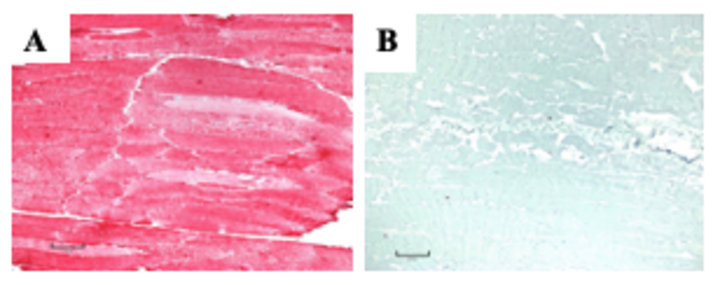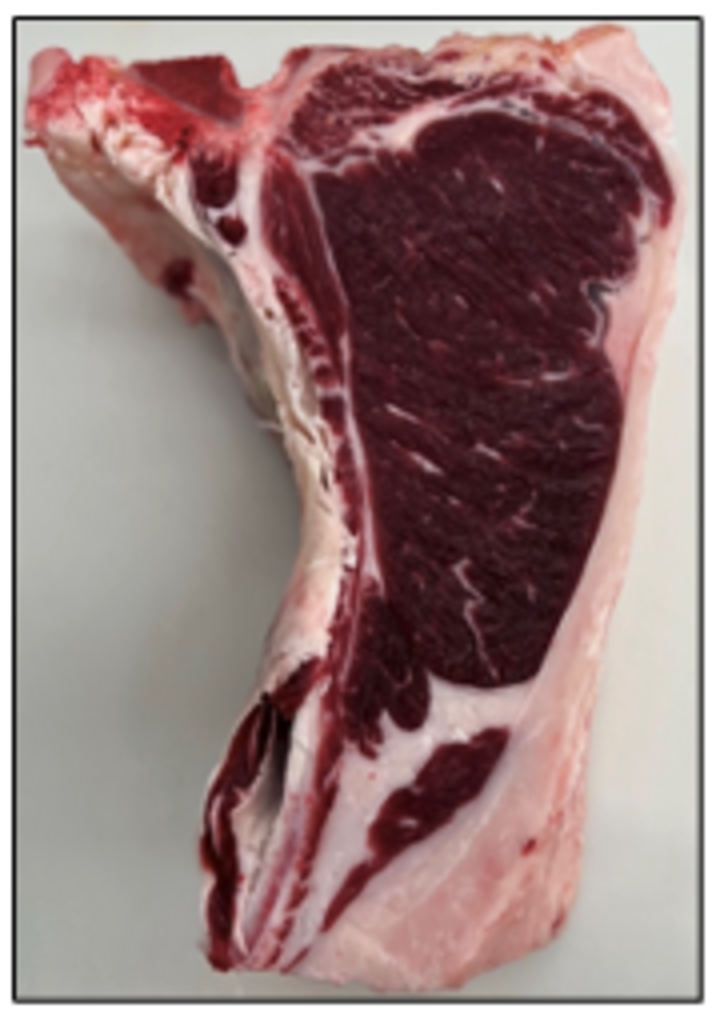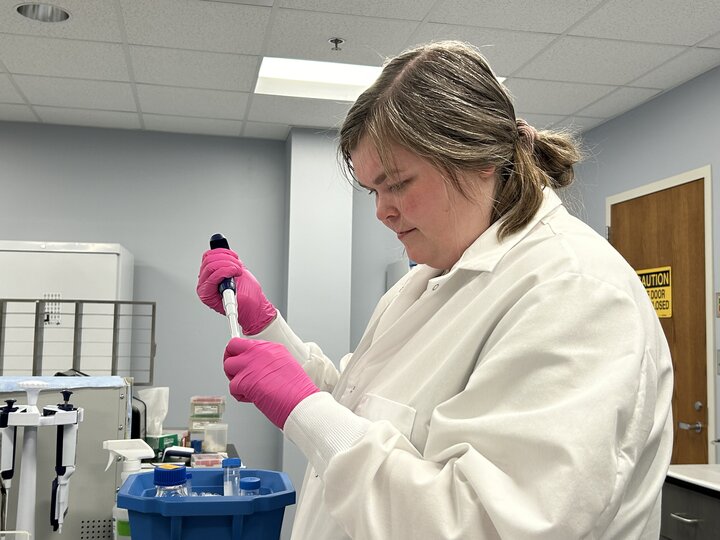Cattle have long been a cornerstone of agriculture, providing us with milk, meat, and various other products that nourish and sustain our communities. Ensuring the cattle’s health and optimal muscle development is vital when producing high-quality beef. However, various genetic conditions can disrupt muscle metabolism, affecting animals’ well-being and the quality of the meat they produce.
Researchers at the University of Nebraska — Lincoln have discovered a new defect in composite cattle (Simmental, Red Angus, Gelbvieh) that often caused physical collapse when they exercised, with some calves unable to recover. This is an autosomal recessive genetic defect, which means both parents of affected calves must carry one copy of the mutation.
Herd managers at the UNL Gudmundsen Sandhills Laboratory noticed calves from one to six months old lagging behind the herd when moving between pastures. When they increased their pace, calves would collapse and remain at rest for brief periods of time. Pedigree analysis revealed a common herd bull in the sire pedigree of each affected calf. Pedigrees of the dams were unavailable, but heifers were retained as replacements within the herd and were sometimes mated to related bulls. This led to the possibility of inbreeding and suggested that a recessive genetic variant may be responsible for exercise intolerance in these calves.
The herd had undergone routine genotyping as part of the Integrated Beef Systems Initiative Genomics Infrastructure project, enabling a rapid genomic-based approach to finding the causative mutation. A genome-wide association study on 721 animals, including six affected calves, and whole-genome sequencing on two affected calves pinpointed a significant region on chromosome 29. One mutation, not previously identified in this region, was predicted to truncate the protein product of the gene PYGM (glycogen phosphorylase). Due to the expected impact of this variant on the myophosphorylase protein encoded by PYGM and the identification of a previously discovered PYGM variant in Charolais cattle, this variant was prioritized for follow-up studies. Next, 381 cattle, including eight affected calves, were genotyped for this variant. In every case, both parents of the affected calf were found to carry one copy of the mutation, and each affected calf had two copies, as we would expect for a recessive genetic variant.
The problem
The myophosphorylase encoded by PYGM plays a vital role in breaking down glycogen into usable energy, fueling muscles for sustained activity. Imagine coins (glycogen) collected and saved in a piggy bank (muscle). Myophosphorylase is the key that opens the piggy bank when animals need more energy. If myophosphorylase is absent or not functioning properly, the breakdown of glycogen is compromised, and the energy is not accessible, leading to difficulties in physical activity and muscle damage.
The affected calves showed a significant increase in glycogen stored in skeletal muscle, almost twice as much as the normal and carrier animals. Additionally, the affected calves had elevated creatine kinase before and after forced exercise. This is an essential enzyme that aids in energy production during muscle contraction. Elevated creatine kinase is often a sign of muscle damage or stress. The calves also experienced twitching in their hind limbs and biopsies showed visible signs of muscle damage. Despite these muscle-related issues, microscopic examination of other organs revealed no abnormalities.
The myophosphorylase protein was found in the healthy animal but noticeably missing in the affected calf. This outcome aligned with an additional test, where specific antibodies were used to identify the PYGM protein in the muscle. The normal calf displayed a positive result with red pigmentation (Figure 1A), while the affected calves distinctly lacked the PYGM protein (Figure 1B).
Figure 1. (A) Stain for myophosphorylase protein (red color) in a normal calf. (B) Stain for myophosphorylase protein in an affected calf.

The inability to efficiently break down glycogen not only compromises the well-being of the animals but also negatively impacts the quality of the meat they produce. Breaking down stored glycogen efficiently after an animal is harvested is crucial for making high-quality beef. In the absence of myophosphorylase, glycogen breakdown is restricted, hindering the expected decrease in pH. Consequently, the affected calves are labeled as dark-cutters, exhibiting dark-red meat that may have a purplish hue instead of the desired vibrant cherry-red color (Figure 2). This adversely influences consumer perception, shortens the product’s shelf life, and leads to economic losses. It is important to note that there were no significant disparities in meat quality in the animals carrying only one copy of the mutation.
Figure 2. Ribeye from an affected calf 24 hours after harvest.

Mutations in the same gene in humans result in a disease similar to what is observed in these cattle, termed McArdle disease. Individuals with McArdle disease experience muscle fatigue and weakness during physical activities, making it difficult to complete tasks requiring sustained effort. Affected individuals can live relatively normal lives by adjusting diet and exercise. However, doing the same for cattle, especially those raised for production, is less practical and achievable. Additionally, the economic benefits of managing this condition in cattle is limited due to the impact on product quality.
This recessive condition significantly affects muscle metabolism, raising concerns about animal welfare and introducing economic challenges in raising livestock. These repercussions can affect the survival of animals and, subsequently, the quality of the meat they produce at harvest. While the issue of dark-cutting beef is not new, understanding the underlying genetic factors at play is limited. This study stands out as one of the initial efforts to pinpoint a specific genetic mutation linked to this condition, paving the way for future research into the genetics of dark-cutting beef. Even though animals carrying one copy of this mutation do not show an immediate negative impact on the beef industry, it is imperative to identify them in breeding herds to prevent the production of affected calves. This comprehensive understanding is crucial for the well-being of the animals and the quality assurance of the final product.
This collaborative effort involved UNL students and faculty across disciplines including graduate student researchers Mackenzie Batt, Leila Venzor, Rachel Reith, and Nicolas Herrera, Dr. Jessica Petersen and Dr. Matt Spangler in animal breeding and genetics, Dr. Gary Sullivan in meat science, and Dr. David Steffen with the UNL Veterinary Diagnostic Center. The full paper was published in BMC Genomics and is available at: https://link.springer.com/article/10.1186/s12864-024-10330-1#citeas
Batt, M.C., Venzor, L.G., Gardner, K. et al. An autosomal recessive variant in PYGM causes myophosphorylase deficiency in Red Angus composite cattle. BMC Genomics 25, 417 (2024). https://doi.org/10.1186/s12864-024-10330-1

